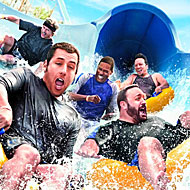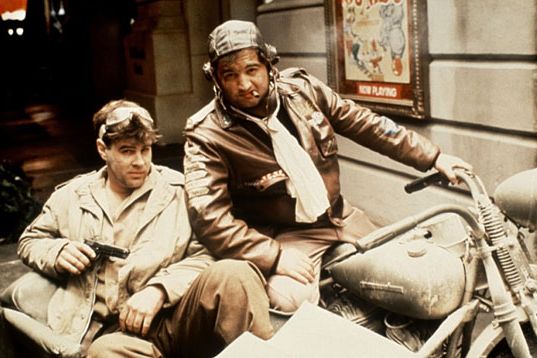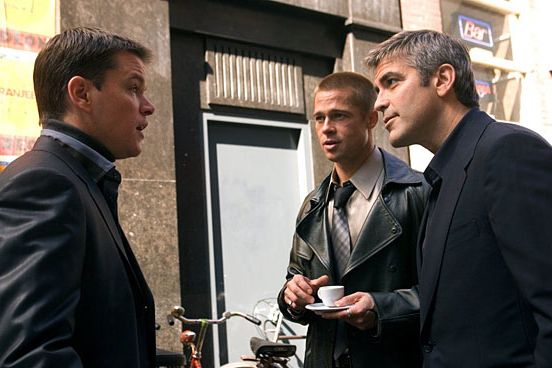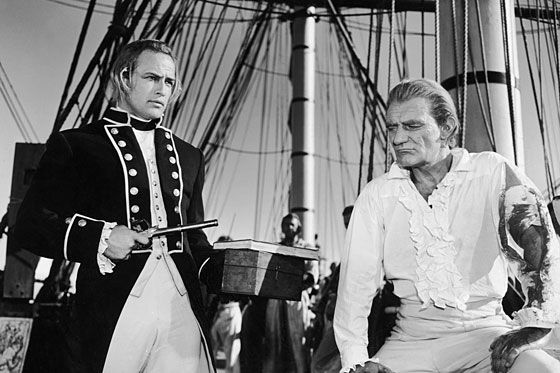Boy, doesn’t it look like Adam Sandler and his old pals had a blast making Grown Ups, hanging out on a lake, riding water slides, peeing in pools, and being paid handily for it? But will it be as enjoyable for the audience? That is unlikely, and not just because it is a movie about grown men peeing in pools: Historically, Hollywood has shown that the amount of fun a cast has making a movie is inversely proportional to the fun moviegoers have watching it. (There are exceptions, of course; the Animal House set certainly sounded like a good place to hang. But by and large, the rule stands.) Here are ten films that should have been turned into home movies for the actors to enjoy privately, rather than subjecting the filmgoing public to them.
The Plot: California wigs out on an epic scale, anticipating a Japanese attack in the days following Pearl Harbor.
The Party: One doesn’t think of a Steven Spielberg movie as being a lax, freewheeling shoot. But not many Spielberg movies feature John Belushi, Dan Aykroyd, and John Candy. The director, fresh off the mythic success of Jaws and Close Encounters, was still in awe of these popular party animals — particularly Belushi and Aykroyd, who turned the set into one big playground where they could wildly drive around in their own vintage New York taxicab and throw out random scene ideas that Spielberg gladly accepted. First assistant director Jerry Ziesmer’s memoir, Ready When You Are, Mr. Coppola, Mr. Spielberg, Mr. Crowe, paints a portrait of an out-of-control set where everybody was constantly cracking each other up …
The Outcome: … which is ironic, since the lumbering 1941 is one of the least funny big-budget studio films ever made, and one of Spielberg’s more notorious flops. He hasn’t directed a real comedy since.
The Plot: The merry band of Vegas thieves from Ocean’s Eleven (George Clooney, Matt Damon, Brad Pitt, etc.) reunites and heads to Europe to stage another heist, so they can pay back the guys they stole from in the first movie.
The Party: Watching the film, it’s not hard to see how much fun these folks had making it, as the whole thing feels like one long party that we haven’t been invited to. The globe-hopping production appears to have been exactly that, right down to an extended sojourn at Clooney’s Lake Como Villa in Italy that turned the small town into Paparazzi Central. And while shooting in Amsterdam, the cast and crew’s hard-partying ways allegedly prompted a memo from Warner Bros. warning about pot use during working hours. Co-star Casey Affleck likened the experience to “summer camp.”
The Outcome: The lowest grossing of the Ocean’s movies, Twelve set new standards for Hollywood indulgence. “At the rate things are going, all of Hollywood will put in about a day’s work on Ocean’s Seventeen,” quipped USA Today.
The Plot: An elaborate, expansive version of the classic seafaring story, on which the studio spared no expense — building a working replica of “The Bounty” and sailing it to the film’s real South Sea locations.
The Party: Temperamental superstar Marlon Brando basically hijacked the production, regularly flying in expensive food and drink for humongous parties. Some claimed it was a delay tactic; Brando had fallen in love with Polynesia and didn’t want to leave. This was the film on which he met his future wife, Tarita Teriipia; before her he sampled a sizable portion of the region’s young female population, supposedly auditioning them for parts in the film. (His girlfriend back home, Rita Moreno, attempted suicide upon hearing these reports.) The cast and the crew followed Brando’s lead, and many of them contracted gonorrhea, necessitating special doctors being flown out from California. Meanwhile, extras were constantly being replaced owing to unforeseen pregnancies.
The Outcome: The film was nominated for a bunch of Oscars, but that most likely was the result of studio arm-twisting: It was a pretty notorious flop for its time and has become one of Hollywood’s favorite cautionary tales.
The Plot: The Beatles (reteamed with their Hard Day’s Night director, Richard Lester) are chased around the world by a murderous Eastern cult that wants to sacrifice Ringo to their goddess.
The Party: “A hell of a lot of pot was being smoked while we were making the film. It was great,” recalled Ringo Starr. “Nobody could communicate with us, it was all glazed eyes and giggling all the time,” said John Lennon. The Fab Four were initially dissatisfied with the film’s disjointedness, but they had no one but themselves to blame: Scenes set in the Bahamas were written because they asked for sunny locations, and scenes set in the Alps were written so they could go skiing. On their downtime, the band rented and crashed sports cars into each other for fun. Still, some good things came of it: John Lennon discovered his trademark granny glasses during the making of this film, and George Harrison discovered the sitar.
The Outcome: Though the film was initially financially successful, it is largely considered the least of the band’s filmic endeavors.
The Plot: Director-star Dennis Hopper plays a stuntman who quits the movies and stays behind in a Peruvian village, where he takes part in a violently absurdist fantasy ritual involving the local Indians.
The Party: “
Peru has painfully learned to live with earthquakes, avalanches, tidal waves, jaguars and poisonous snakes. But Dennis Hopper was something else.” So began an infamous
Life magazine article detailing the production of this existentialist avant-Western, which Hopper convinced Universal to let him shoot in Peru in part because the drugs were so much cheaper and easier to procure. Accompanied by some of the era’s most infamous wild men, including Peter Fonda, Dean Stockwell, Russ Tamblyn, and Kris Kristofferson, the actor-director ran wild, improvising the film by day and tripping his brains out by night. The revelry was broad and varied (the
Life article refers cryptically to something called “whipping parties”), and it reached almost homicidal levels: One actor reportedly tried to set a girl on fire, convinced she looked like Joan of Arc.
The Outcome: Though it has attained cult status over the years,
The Last Movie was such a disaster upon its release that it almost killed Hopper’s career. He wouldn’t direct again until nearly a decade later.
The Plot: Warren Beatty and Jack Nicholson play two dim-bulbs who vie for the affections of heiress Stockard Channing, then try to find a way to bilk her out of her money.
The Party: Beatty and Nicholson had always wanted to work together, which maybe explains why they dove into this film despite not having a coherent script to work with; screenwriter Carole Eastman’s draft was 240 pages with no ending. But the two actors enjoyed each other’s (and director Mike Nichols’s) company so much that they just decided to wing it, hoping their collective brilliance would make it all come together in the end. And apparently, they were convinced their plan was working: Frank Rich, who visited the set for Times, noted, “I heard the word ‘wonderful’ more times in ten days than I had heard it in my entire life.”
The Outcome: An enormous flop, The Fortune is largely forgotten today. Nicholson and Beatty luckily had One Flew Over the Cuckoo’s Nest and Shampoo out the same year, but Nichols’s directing career took many years to recover.
The Plot: In an even looser and more star-studded follow-up to the loose, star-studded Cannonball Run, a cast of familiar faces (Burt Reynolds, Dom DeLuise, Jamie Farr, Jackie Chan, the guy who played “Jaws” in the Bond flicks, an orangutan, etc.) once again races across the country in a diverse assortment of cars.
The Party: Both Cannonball Run movies were just excuses for a bunch of stars to hang out and cash some paychecks, but the first one was practically a Kubrick film compared to the sequel, where they didn’t even bother with a script. “Sheer arrogance made this picture,” wrote Roger Ebert, and it shows: The movie basically is the party, with DeLuise and Reynolds in-joking their way to irrelevance, while fading giants like Frank Sinatra, Dean Martin, and other reunited Rat Packers try hard to look sober. The whole thing was so lackadaisical that they didn’t even bother to shoot the race itself, letting animated segments by Ralph Bakshi take care of that.
The Outcome: Remember how Burt Reynolds was huge once and is now basically just a punchline? This movie started that process.
The Plot: In a loose riff on Alexander Dumas’s classic tale, Cheech and Chong play two brothers, separated at birth, who get entangled in a variety of mishaps in pre-revolutionary France.
The Party: You’d think that a Cheech and Chong production would be a wild, debauched affair. However, the problem on the dope-free Corsican Brothers wasn’t so much substance abuse but fame, freedom, and comfort: The stoner duo had been given a large budget, a 600-acre French estate, and a 500-room castle to run wild on, and brought their families along for the occasion. Tommy Chong, who directed, even cast his father, wife, and daughters in the film. “Everything was perfect. Too perfect,” Chong wrote in Cheech & Chong: The Unauthorized Biography.
The Outcome: Did we mention the plot was dope-free? With the drug angle removed from their shtick, suddenly Cheech and Chong’s humor stopped working, and this is widely regarded as the worst of their films, which is saying a lot.
The Plot: In Alex Cox’s apocalyptic post-punk spaghetti Western, a trio of hapless crooks takes on a town full of crazed, coffee-addicted cowboys.
The Party: The movie itself wasn’t even supposed to happen: Director Cox (Sid & Nancy, Repo Man) and producer Eric Fellner had organized a tour of Nicaragua by the Pogues, Elvis Costello, and Joe Strummer to show support for the Sandinista government. Unable to fund the controversial tour, they decided to shoot a movie in Spain with the bands instead. And as you might expect from any gathering that included not only Joe Strummer and the Pogues but a young Courtney Love as well, the whole thing turned into a four-week orgy of booze and narcotics, with some members of the Pogues (whom Cox lovingly described as “slimy, horrible exponents of decadence and naughtiness”) occasionally waking up in gutters and needing daily injections of B12 to remain even mildly functional.
The Outcome: Rumor had it that the script was written in three days, so it’s perhaps understandable that the movie flopped and was savaged by critics, many of whom acknowledged that it was instant midnight-movie fodder.
The Plot: Vince Vaughn, Jon Favreau, Jason Bateman, Faizon Love, and their significant others head to a remote, beautiful island resort to work on relationship issues both real and imagined.
The Party: Try as the cast did to pretend that they were working, all everybody talked about in the production notes was the location, a real five-star resort on Bora Bora where Vince Vaughn had his own 3,455-square-foot “Royal Over-water Pool Villa,” with its own private stairway into a lagoon for jet-skiing, and where director Peter Billingsley was most taken with the glass floor in his bungalow that allowed him to see the fish swimming below. Billingsley even admitted that sometimes it was hard to
keep his cast focused on the work at hand. No kidding?
The Outcome: Unfunny and caustic, the film was still kind of a hit, but that was likely because in its October release, audiences were eager for a vicarious tropical vacation.
















